
Poison dart frog is the common name of a group of frogs in the family Dendrobatidae which are native to tropical Central and South America. These species are diurnal and often have brightly colored bodies. This bright coloration is correlated with the toxicity of the species, making them aposematic. Some species of the family Dendrobatidae exhibit extremely bright coloration along with high toxicity — a feature derived from their diet of ants, mites and termites— while species which eat a much larger variety of prey have cryptic coloration with minimal to no amount of observed toxicity. Many species of this family are threatened due to human infrastructure encroaching on their habitats.

The strawberry poison frog, strawberry poison-dart frog or blue jeans poison frog is a species of small poison dart frog found in Central America. It is common throughout its range, which extends from eastern central Nicaragua through Costa Rica and northwestern Panamá. The species is often found in humid lowlands and premontane forest, but large populations are also found in disturbed areas such as plantations. The strawberry poison frog is perhaps most famous for its widespread variation in coloration, comprising approximately 15–30 color morphs, most of which are presumed to be true-breeding. O. pumilio, while not the most poisonous of the dendrobatids, is the most toxic member of its genus.

Dendrobates is a genus of poison dart frogs native to Central and South America. It once contained numerous species, but most originally placed in this genus have been split off into other genera such as Adelphobates, Ameerega, Andinobates, Epipedobates, Excidobates, Oophaga, Phyllobates and Ranitomeya, leaving only five large to medium-sized species in the genus Dendrobates. All the other genera used to be grouped in with Dendrobates because it was previously thought that all brightly colored poison dart frogs came from the same ancestor but this has since been proven to be incorrect. Dendrobates and Phyllobates evolved conspicuous coloration from the same common ancestor but not the same as any of the other genera listed above.
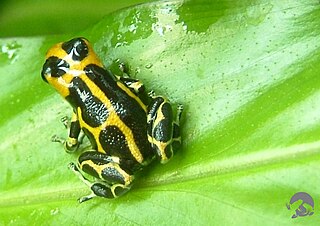
Ranitomeya imitator, is a species of poison dart frog found in the north-central region of eastern Peru. Its common names include mimic poison frog and poison arrow frog, and it is one of the best known dart frogs. It was discovered in the late 1980s by Rainer Schulte who later split it up into more subspecies; describing each as a specific color morph, and sometimes having a separate behavioral pattern. The acoustics, morphs, and behavior of the species have been extensively researched.
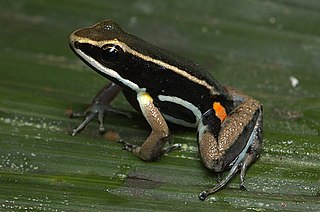
The Aromobatidae are a family of frogs native to Central and South America. They are sometimes referred to as cryptic forest frogs or cryptic poison frogs. They are the sister taxon of the Dendrobatidae, the poison dart frogs, but are not as toxic as most dendrobatids are.
Ranitomeya flavovittata is a species of frog in the family Dendrobatidae. It is endemic to Peru and known with certainty only from the Loreto Region where its type locality is.

The blue-bellied poison frog or bluebelly poison frog is a species of frog in the family Dendrobatidae.
Ranitomeya rubrocephala is a species of frog of doubtful taxonomic status in the family Dendrobatidae.

Ranitomeya vanzolinii, also known as the Brazilian poison frog or spotted poison frog, is a species of frog in the Ranitomeya genus, from the poison dart frog family, Dendrobatidae. It is found in the Amazonian rainforests of Brazil and Perú, and possibly Bolivia.
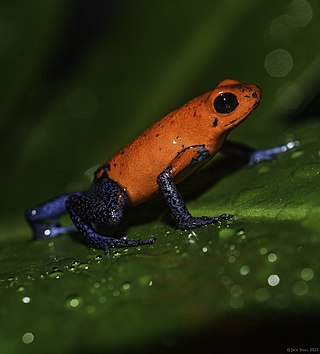
Oophaga is a genus of poison-dart frogs containing twelve species, many of which were formerly placed in the genus Dendrobates. The frogs are distributed in Central and South America, from Nicaragua south through the El Chocó to northern Ecuador. Their habitats vary with some species being arboreal while other being terrestrial, but the common feature is that their tadpoles are obligate egg feeders. Most species in this genus are seriously threatened and O. speciosa is already extinct.

Ameerega is a genus of poison dart frogs in the family Dendrobatidae. These frogs live around rocks that are nearby streams. They are found in central South America north to Panama. It contains many former species of the genus Epipedobates.

Adelphobates is a small genus of poison dart frogs. They are found in the central and lower Amazon basin of Peru and Brazil, possibly Bolivia. It was originally erected as a sister group to the Dendrobates and Oophaga genera. The validity of the genus is still being discussed, with the alternative being "Dendrobates galactonotus group" within Dendrobates. One species originally placed in this genus as Adelphobates captivus has since been moved to the genus Excidobates erected in 2008.

Ranitomeya amazonica is a poison dart frog in the genus Ranitomeya. It was first described by Rainer Schulte in 1999 as Dendrobates amazonicus when he separated it from Dendrobates ventrimaculatus, primarily on the basis of call characteristics. The validity of the species has been debated, but further studies, also including genetic data, support its validity.

Ranitomeya variabilis, formerly known as Dendrodates variabilis, is a species of small poison dart frog distributed in northern Peru, along the eastern slope of Andes in the upper Rio Huallaga drainage basin. Its common name, Zimmerman's poison frog, is named after Elke Zimmermann, a German zoologist who described the morph of this species and differentiated it from D. ventrimaculatus. The species was formerly considered to be synonymous with Ranitomeya ventrimaculata.

Dendrobatinae is the main subfamily of frogs in the family Dendrobatidae, the poison dart frogs of Central and South America, found from Nicaragua to the Amazon basin in Brazil.

Andinobates is a genus of poison dart frogs from Ecuador, Colombia and Panama. It contains species formerly classified in the genus Dendrobates and in 2006 transferred to the genus Ranitomeya. In 2011 Twomey, Brown, and their colleagues erected the genus Andinobates for a group of 12 species of Ranitomeya. Andinobates frogs can be distinguished from their sister taxon Ranitomeya anatomically in that their 2nd and 3rd vertebrae are fused. They show no limb reticulation, which is present in most species of Ranitomeya.
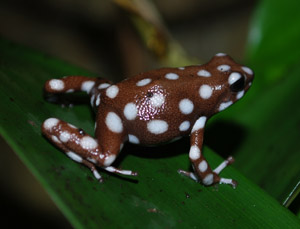
Excidobates is a genus of poison dart frogs endemic to the Marañón River drainage in Peru and Ecuador, South America. At one time members of this genus were classified as Dendrobates. A characteristic of this genus is the presence of pale, ovoid spots on the under surface of the thighs.

Ranitomeya summersi, sometimes referred to as Summers' poison frog, is a species of poison dart frogs found in the central Huallaga River drainage and adjacent Cordillera Azul National Park in central Peru. Before 2008, the species was considered a subspecies of Ranitomeya fantastica. The IUCN considers it an endangered species because of limited habitat range, habitat loss, and collection for the pet trade.

Ranitomeya benedicta, sometimes called the blessed poison frog, is a species of poison dart frogs found in the lowland rainforest of the Pampas del Sacramento in southern Loreto and eastern San Martín Region, northeastern Peru. Before 2008, the species was considered a subspecies of Ranitomeya fantastica. The IUCN considers the species vulnerable because of limited habitat range, habitat loss, and collection for the pet trade.
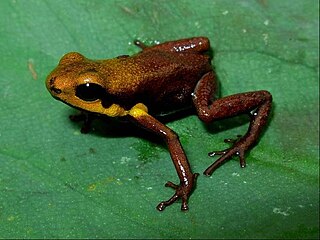
Andinobates tolimensis, the Tolimense poison frog, is a species of amphibian in the family Dendrobatidae, endemic to Colombia in the outskirts of Falan and north of the department of Tolima. Previously it was included in the genus Ranitomeya, but was reclassified in Andinobates, along with 11 other species. It is threatened by habitat loss. It is toxic to humans and when captured will excrete a milky substance.




























